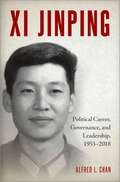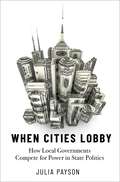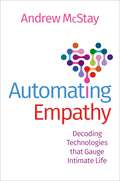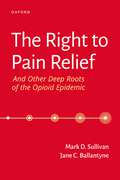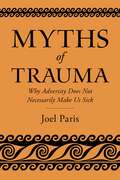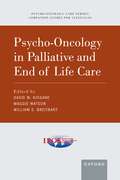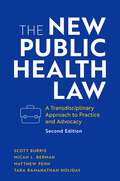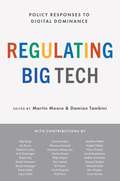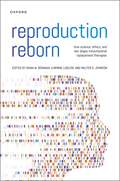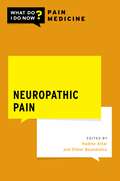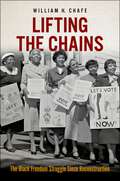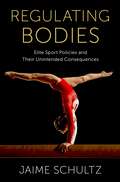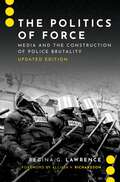- Table View
- List View
Xi Jinping: Political Career, Governance, and Leadership, 1953-2018
by Alfred L. ChanXi Jinping has proven to be one of the most transformative political leaders of the twenty-first century. After a long career that began at the village level, he became General Secretary of the Chinese Communist Party and China's paramount leader in 2012. Few expected what would come next: a sweeping restructuring of China's political economy and political culture which included anti-corruption campaigns against the Party, and a full recalibration of China's relations with the outside world. In Xi Jinping, Alfred L. Chan offers a comprehensive account of his life and times. Chan discusses Xi's early years as a "princeling" and his ordeal during the tumultuous Cultural Revolution. Xi's privileged childhood was shattered during his youth when he was mercilessly tormented as a counter-revolutionary, declared a juvenile delinquent and pauper, ultimately becoming an ordinary peasant. But he clawed his way back up a ladder of success reflecting the changing zeitgeist of the times. He entered politics at age seventeen and accumulated administrative experiences at the county and provincial levels. Chan documents Xi's long path upward through the system, revealing how he built a reputation as an astute leader and a corruption fighter. The second half of the book focuses on the post-2012 period, and Chan pays particular attention to the context surrounding Xi's governance once he consolidated power. He makes clear that Xi's core guiding principle has been Leninism, which prioritizes disciplined party rule above all else. Throughout, Chan applies a range of social scientific theories drawn from comparative politics, international relations theory, public policy, and theories of governance to explain policymaking during an era of turbulent changes. Sweeping in scope and addressing virtually every aspect of Xi's life, this study will be essential for anyone seeking to understand not just Xi himself, but the overlapping global and domestic political contexts that shaped his career and style of rule.
Xi Jinping: Political Career, Governance, and Leadership, 1953-2018
by Alfred L. ChanXi Jinping has proven to be one of the most transformative political leaders of the twenty-first century. After a long career that began at the village level, he became General Secretary of the Chinese Communist Party and China's paramount leader in 2012. Few expected what would come next: a sweeping restructuring of China's political economy and political culture which included anti-corruption campaigns against the Party, and a full recalibration of China's relations with the outside world. In Xi Jinping, Alfred L. Chan offers a comprehensive account of his life and times. Chan discusses Xi's early years as a "princeling" and his ordeal during the tumultuous Cultural Revolution. Xi's privileged childhood was shattered during his youth when he was mercilessly tormented as a counter-revolutionary, declared a juvenile delinquent and pauper, ultimately becoming an ordinary peasant. But he clawed his way back up a ladder of success reflecting the changing zeitgeist of the times. He entered politics at age seventeen and accumulated administrative experiences at the county and provincial levels. Chan documents Xi's long path upward through the system, revealing how he built a reputation as an astute leader and a corruption fighter. The second half of the book focuses on the post-2012 period, and Chan pays particular attention to the context surrounding Xi's governance once he consolidated power. He makes clear that Xi's core guiding principle has been Leninism, which prioritizes disciplined party rule above all else. Throughout, Chan applies a range of social scientific theories drawn from comparative politics, international relations theory, public policy, and theories of governance to explain policymaking during an era of turbulent changes. Sweeping in scope and addressing virtually every aspect of Xi's life, this study will be essential for anyone seeking to understand not just Xi himself, but the overlapping global and domestic political contexts that shaped his career and style of rule.
When Cities Lobby: How Local Governments Compete for Power in State Politics
by Julia PaysonIn a political environment characterized by intense urban-rural polarization and growing hostility between cities and state legislatures, When Cities Lobby explores how local officials use lobbyists to compete for power in state politics. When Cities Lobby tells the story of what happens when city officials rely on professional lobbyists to represent their interests in state government. In a political environment characterized by intense urban-rural polarization and growing hostility between cities and state legislatures, the ability to lobby offers a powerful tool for city leaders seeking to amplify their voices in state politics. The cities that lobby at the highest rates include large urban centers that have historically faced obstacles to effective representation in our federal system, and, increasingly, blue-leaning cities engaged in preemption battles against Republican-led legislatures. But high-income places have also figured out how to strategically use lobbyists, and these communities have become particularly adept at lobbying to secure additional grant money and shift state funding in a direction that favors them. How did we end up with a system where political officials in different levels of government often choose to pay lobbyists to facilitate communication between them, and are the potential benefits worth the costs? Author Julia Payson demonstrates that the answer is deeply rooted in both the nature of the federal system and the evolution of the professional lobbying industry. While some states have recently debated measures to restrict lobbying by local governments, these efforts will likely do more harm than good in the absence of structural reforms to the lobbying industry more broadly.
When Cities Lobby: How Local Governments Compete for Power in State Politics
by Julia PaysonIn a political environment characterized by intense urban-rural polarization and growing hostility between cities and state legislatures, When Cities Lobby explores how local officials use lobbyists to compete for power in state politics. When Cities Lobby tells the story of what happens when city officials rely on professional lobbyists to represent their interests in state government. In a political environment characterized by intense urban-rural polarization and growing hostility between cities and state legislatures, the ability to lobby offers a powerful tool for city leaders seeking to amplify their voices in state politics. The cities that lobby at the highest rates include large urban centers that have historically faced obstacles to effective representation in our federal system, and, increasingly, blue-leaning cities engaged in preemption battles against Republican-led legislatures. But high-income places have also figured out how to strategically use lobbyists, and these communities have become particularly adept at lobbying to secure additional grant money and shift state funding in a direction that favors them. How did we end up with a system where political officials in different levels of government often choose to pay lobbyists to facilitate communication between them, and are the potential benefits worth the costs? Author Julia Payson demonstrates that the answer is deeply rooted in both the nature of the federal system and the evolution of the professional lobbying industry. While some states have recently debated measures to restrict lobbying by local governments, these efforts will likely do more harm than good in the absence of structural reforms to the lobbying industry more broadly.
Automating Empathy: Decoding Technologies that Gauge Intimate Life
by Andrew McStayThis is an open access title. It is made available under a Creative Commons Attribution-Non Commercial-No Derivatives 4.0 International license. It is available to read and download as a PDF version on the Oxford Academic platform. We live in a world where artificial intelligence and intensive use of personal data has become normalized. Companies across the world are developing and launching technologies to infer and interact with emotions, mental states, and human conditions. However, the methods and means of mediating information about people and their emotional states are incomplete and problematic. Automating Empathy offers a critical exploration of technologies that sense intimate dimensions of human life and the modern ethical questions raised by attempts to perform and simulate empathy. It traces the ascendance of empathic technologies from their origins in physiognomy and pathognomy to the modern day and explores technologies in nations with non-Western ethical histories and approaches to emotion, such as Japan. The book examines applications of empathic technologies across sectors such as education, policing, and transportation, and considers key questions of everyday use such as the integration of human-state sensing in mixed reality, the use of neurotechnologies, and the moral limits of using data gleaned through automated empathy. Ultimately, Automating Empathy outlines the key principles necessary to usher in a future where automated empathy can serve and do good. Drawing insights across ethics, philosophy, and policy, Automating Empathy argues for a pluralistic reconceptualization of empathic technologies to better reflect the intimate dimensions of human life.
Automating Empathy: Decoding Technologies that Gauge Intimate Life
by Andrew McStayThis is an open access title. It is made available under a Creative Commons Attribution-Non Commercial-No Derivatives 4.0 International license. It is available to read and download as a PDF version on the Oxford Academic platform. We live in a world where artificial intelligence and intensive use of personal data has become normalized. Companies across the world are developing and launching technologies to infer and interact with emotions, mental states, and human conditions. However, the methods and means of mediating information about people and their emotional states are incomplete and problematic. Automating Empathy offers a critical exploration of technologies that sense intimate dimensions of human life and the modern ethical questions raised by attempts to perform and simulate empathy. It traces the ascendance of empathic technologies from their origins in physiognomy and pathognomy to the modern day and explores technologies in nations with non-Western ethical histories and approaches to emotion, such as Japan. The book examines applications of empathic technologies across sectors such as education, policing, and transportation, and considers key questions of everyday use such as the integration of human-state sensing in mixed reality, the use of neurotechnologies, and the moral limits of using data gleaned through automated empathy. Ultimately, Automating Empathy outlines the key principles necessary to usher in a future where automated empathy can serve and do good. Drawing insights across ethics, philosophy, and policy, Automating Empathy argues for a pluralistic reconceptualization of empathic technologies to better reflect the intimate dimensions of human life.
The Right to Pain Relief and Other Deep Roots of the Opioid Epidemic
by Mark Sullivan Jane BallantyneThe Right to Pain Relief and Other Deep Roots of the Opioid Epidemic offers a new lens through which to view the opioid epidemic as a consequence of serious misunderstandings of both opioids and pain. Based on their extensive research and experience with chronic pain care, science, ethics, and policy, the authors look beyond the usual villains-pharmaceutical companies and pharmacotherapy distributors-to examine the ethical and scientific concepts about pain that made the opioid epidemic possible. The book explores the history of pain in Western society, the role of innovation in end-of-life care, the conception of pain control as an important medical responsibility, and the various models of pain that have led to our current understanding of it, ultimately arguing that we must reintegrate pain with the rest of human suffering as a necessary part of a full life. Containing patient vignettes as well as scientific and policy controversies that have emerged as the opioid epidemic has evolved, The Right to Pain Relief and Other Deep Roots of the Opioid Epidemic examines these implications in a more human and holistic way than has been ever addressed before by the popular press and professional literature.
The Right to Pain Relief and Other Deep Roots of the Opioid Epidemic
by Mark Sullivan Jane BallantyneThe Right to Pain Relief and Other Deep Roots of the Opioid Epidemic offers a new lens through which to view the opioid epidemic as a consequence of serious misunderstandings of both opioids and pain. Based on their extensive research and experience with chronic pain care, science, ethics, and policy, the authors look beyond the usual villains-pharmaceutical companies and pharmacotherapy distributors-to examine the ethical and scientific concepts about pain that made the opioid epidemic possible. The book explores the history of pain in Western society, the role of innovation in end-of-life care, the conception of pain control as an important medical responsibility, and the various models of pain that have led to our current understanding of it, ultimately arguing that we must reintegrate pain with the rest of human suffering as a necessary part of a full life. Containing patient vignettes as well as scientific and policy controversies that have emerged as the opioid epidemic has evolved, The Right to Pain Relief and Other Deep Roots of the Opioid Epidemic examines these implications in a more human and holistic way than has been ever addressed before by the popular press and professional literature.
Myths of Trauma: Why Adversity Does Not Necessarily Make Us Sick
by Joel ParisPost-traumatic stress disorder (PTSD) is a serious and sometimes debilitating mental disorder. Yet only about one in ten people who are exposed to significant traumatic events develop PTSD. Since its inclusion in the Diagnostic and Statistical Manual (DSM) in 1980, the definition of PTSD has been controversial. Various changes made to the criteria have gradually widened the diagnostic criteria, which now include experiences that may not involve direct exposure to trauma, which in turn has led to PTSD to be over-diagnosed: clinicians may be tempted to seize on traumatic events in a history as an explanation of mental disorders, while patients may automatically receive the diagnosis if they experienced major trauma in the past. Myths of Trauma is a timely and important book that probes the sensitive, emotional, and often controversial subject of trauma, the difficulties associated with its diagnosis, and the over-diagnosis of PTSD. Trauma has become a catch-all for many kinds of adverse experiences, when in reality, people are significantly resilient to traumatic events. The book also explores how responses to trauma develop in the context of multiple interwoven risk factors, ranging from genetic vulnerability effecting sensitivity to the environment, as well as past adversities; how trauma has become a political issue that interferes with unbiased scientific study of its effects; and how trauma narratives can have a darker side when patients use them to justify feelings of victimhood that interfere with their own agency. Integrating and analysing the vast quantities of scientific literature on the topic, Myths of Trauma teaches us not to think about trauma in isolation or as one thing rather than many different things. The experiences of trauma deserve a place in clinical practice, and it is time for PTSD to be viewed through a more complex and multidimensional lens within the broader biopsychosocial context.
Myths of Trauma: Why Adversity Does Not Necessarily Make Us Sick
by Joel ParisPost-traumatic stress disorder (PTSD) is a serious and sometimes debilitating mental disorder. Yet only about one in ten people who are exposed to significant traumatic events develop PTSD. Since its inclusion in the Diagnostic and Statistical Manual (DSM) in 1980, the definition of PTSD has been controversial. Various changes made to the criteria have gradually widened the diagnostic criteria, which now include experiences that may not involve direct exposure to trauma, which in turn has led to PTSD to be over-diagnosed: clinicians may be tempted to seize on traumatic events in a history as an explanation of mental disorders, while patients may automatically receive the diagnosis if they experienced major trauma in the past. Myths of Trauma is a timely and important book that probes the sensitive, emotional, and often controversial subject of trauma, the difficulties associated with its diagnosis, and the over-diagnosis of PTSD. Trauma has become a catch-all for many kinds of adverse experiences, when in reality, people are significantly resilient to traumatic events. The book also explores how responses to trauma develop in the context of multiple interwoven risk factors, ranging from genetic vulnerability effecting sensitivity to the environment, as well as past adversities; how trauma has become a political issue that interferes with unbiased scientific study of its effects; and how trauma narratives can have a darker side when patients use them to justify feelings of victimhood that interfere with their own agency. Integrating and analysing the vast quantities of scientific literature on the topic, Myths of Trauma teaches us not to think about trauma in isolation or as one thing rather than many different things. The experiences of trauma deserve a place in clinical practice, and it is time for PTSD to be viewed through a more complex and multidimensional lens within the broader biopsychosocial context.
Psycho-Oncology in Palliative and End of Life Care (PSYCHO ONCOLOGY CARE)
Psycho-Oncology in Palliative and End-of-Life Care provides expert advice and clinical management guidelines on the impact of advanced cancer and its treatment on the life and wellbeing of a patient in palliative and end-of-life care. Employing a practical toolkit format, this volume addresses a variety of key challenges including: discussions of death and dying, poor prognoses, wishes and values of the dying person, advance care plans, anxiety, demoralization and problems with coping, depression and delirium, the needs of partners, children, families, and caregivers, and spiritual and bereavement care. Each chapter considers presenting symptoms, differential diagnoses and assessment methods to achieve the best diagnosis, so that a detailed formulation can be developed for each person that guides a comprehensive management plan. Each section concludes with professional and service issues ranging from ethical dilemmas, legal requirements, cultural needs, and training and service development issues, through to basic human rights. Part of the Psycho-Oncology Care: Companion Guides for Clinicians series, this concise pocket guide is a resource for oncology specialists, psycho-oncologists in training, consultant nurse specialists and nurse practitioners, and allied health professionals to use as a quick reference in everyday practice. Pitched at intermediate to advanced level skills, this companion guide can be used as a standalone, or alongside existing oncology and psycho-oncology training programs.
Psycho-Oncology in Palliative and End of Life Care (PSYCHO ONCOLOGY CARE)
by David W. Kissane, Maggie Watson and William S. BreitbartPsycho-Oncology in Palliative and End-of-Life Care provides expert advice and clinical management guidelines on the impact of advanced cancer and its treatment on the life and wellbeing of a patient in palliative and end-of-life care. Employing a practical toolkit format, this volume addresses a variety of key challenges including: discussions of death and dying, poor prognoses, wishes and values of the dying person, advance care plans, anxiety, demoralization and problems with coping, depression and delirium, the needs of partners, children, families, and caregivers, and spiritual and bereavement care. Each chapter considers presenting symptoms, differential diagnoses and assessment methods to achieve the best diagnosis, so that a detailed formulation can be developed for each person that guides a comprehensive management plan. Each section concludes with professional and service issues ranging from ethical dilemmas, legal requirements, cultural needs, and training and service development issues, through to basic human rights. Part of the Psycho-Oncology Care: Companion Guides for Clinicians series, this concise pocket guide is a resource for oncology specialists, psycho-oncologists in training, consultant nurse specialists and nurse practitioners, and allied health professionals to use as a quick reference in everyday practice. Pitched at intermediate to advanced level skills, this companion guide can be used as a standalone, or alongside existing oncology and psycho-oncology training programs.
The New Public Health Law: A Transdisciplinary Approach to Practice and Advocacy
by Scott Burris Micah L. Berman Matthew Penn Tara Ramanathan HolidayPublic health law isn't just for lawyers. Or at least it doesn't have to be. Originally published in 2018, The New Public Health Law was the first textbook to arm lawyers and public health professionals of any background with the tools to fully exploit the potential of law to improve public health. This refreshed second edition furthers the transdisciplinary approach of the first edition with key updates to case law and evolving legal changes in response to COVID-19 and worsening health inequities. Suitable for courses in public health, law, and social work, this helpful guidebook offers straightforward chapters that move through the life cycle of public health law practice and legal epidemiology from policy development and advocacy to enforcement and evaluation. It breaks down complex legal processes into discrete and understandable stages with case studies across a wide range of health subjects including chronic disease prevention, injuries and violence, maternal and child health, infectious disease preparedness and response, and food and drug safety. Supported by an online teacher's guide and written for readers of any background, The New Public Health Law, Second Edition is an indispensable roadmap for the difficult work of crafting and improving public health law.
The New Public Health Law: A Transdisciplinary Approach to Practice and Advocacy
by Scott Burris Micah L. Berman Matthew Penn Tara Ramanathan HolidayPublic health law isn't just for lawyers. Or at least it doesn't have to be. Originally published in 2018, The New Public Health Law was the first textbook to arm lawyers and public health professionals of any background with the tools to fully exploit the potential of law to improve public health. This refreshed second edition furthers the transdisciplinary approach of the first edition with key updates to case law and evolving legal changes in response to COVID-19 and structural racism. Suitable for courses in public health, law, and social work, this helpful guidebook offers straightforward chapters that move through the life cycle of public health law practice and legal epidemiology from policy development and advocacy to enforcement and evaluation. It breaks down complex legal processes into discrete and understandable stages with case studies across a wide range of health subjects including chronic disease prevention, injuries and violence, maternal and child health, infectious disease preparedness and response, and food and drug safety. Supported by an online teacher's guide and written for readers of any background, The New Public Health Law, Second Edition is an indispensable roadmap for the difficult work of crafting and improving public health law.
Regulating Big Tech: Policy Responses to Digital Dominance
by Martin Moore Damian TambiniSelected chapters from this book are published open access and free to read or download from Oxford Scholarship Online, https://oxford.universitypressscholarship.com/. Since Digital Dominance was published in 2018, a global consensus has emerged that technology platforms should be regulated. Governments from the United States to Australia have sought to reduce the power of these platforms and curtail the dominance of a few, yet regulatory responses remain fragmented, with some focused solely on competition while others seek to address issues around harm, privacy, and freedom of expression. Regulating Big Tech condenses the vibrant tech policy debate into a toolkit for the policy maker, legal expert, and academic seeking to address one of the key issues facing democracies today: platform dominance and its impact on society. Contributors explore elements of the toolkit through comprehensive coverage of existing and future policy on data, antitrust, competition, freedom of expression, jurisdiction, fake news, elections, liability, and accountability, while also identifying potential policy impacts on global communication, user rights, public welfare, and economic activity. With original chapters from leading academics and policy experts, Regulating Big Tech sets out a policy framework that can address interlocking challenges of contemporary tech regulation and offer actionable solutions for our technological future.
Regulating Big Tech: Policy Responses to Digital Dominance
by Martin Moore and Damian TambiniSelected chapters from this book are published open access and free to read or download from Oxford Scholarship Online, https://oxford.universitypressscholarship.com/. Since Digital Dominance was published in 2018, a global consensus has emerged that technology platforms should be regulated. Governments from the United States to Australia have sought to reduce the power of these platforms and curtail the dominance of a few, yet regulatory responses remain fragmented, with some focused solely on competition while others seek to address issues around harm, privacy, and freedom of expression. Regulating Big Tech condenses the vibrant tech policy debate into a toolkit for the policy maker, legal expert, and academic seeking to address one of the key issues facing democracies today: platform dominance and its impact on society. Contributors explore elements of the toolkit through comprehensive coverage of existing and future policy on data, antitrust, competition, freedom of expression, jurisdiction, fake news, elections, liability, and accountability, while also identifying potential policy impacts on global communication, user rights, public welfare, and economic activity. With original chapters from leading academics and policy experts, Regulating Big Tech sets out a policy framework that can address interlocking challenges of contemporary tech regulation and offer actionable solutions for our technological future.
Reproduction Reborn: How Science, Ethics, and Law Shape Mitochondrial Replacement Therapies
by Diana Bowman Karinne Ludlow Walter G. JohnsonA cutting-edge analysis of the global issues surrounding modern reproductive technologies Advances in assisted reproductive technologies have sparked global policy debates since the birth of the first so-called "test tube baby" in 1978. Today, mitochondrial replacement therapies represent the most recent advancement in assisted reproductive technologies, allowing some women with mitochondrial diseases to birth babies without those diseases. In the past decade, mitochondrial replacement therapies have captured public sentiment, reigniting debates around social views of reproductive rights and the appropriate legal and political response. Reproduction Reborn guides readers through the history and science of mitochondrial replacement therapies and the various attempts to control them. Leading experts from medicine, genetics, ethics, law, and policy explore the influence of public debate on the evolving shape of these technologies and their subsequent regulation. They highlight case studies from both developed and developing countries across the globe, including recent legislation in Australia and China. They further identify the ethical, legal, and societal norms that need to be addressed by policymakers and communities as more and more people seek to gain access to these treatments. Given the importance of reproduction in family life and cultural identity, clinicians and policymakers must understand how regulatory regimes around mitochondrial replacement therapies have evolved to illuminate the processes and challenges of governing reproduction in a fast-moving world. Informative and global in scope, Reproduction Reborn explores how advancements in assisted reproductive technologies challenge core values surrounding the rights and responsibilities of modern-day family units.
Reproduction Reborn: How Science, Ethics, and Law Shape Mitochondrial Replacement Therapies
by Diana Bowman Karinne Ludlow Walter G. JohnsonA cutting-edge analysis of the global issues surrounding modern reproductive technologies Advances in assisted reproductive technologies have sparked global policy debates since the birth of the first so-called "test tube baby" in 1978. Today, mitochondrial replacement therapies represent the most recent advancement in assisted reproductive technologies, allowing some women with mitochondrial diseases to birth babies without those diseases. In the past decade, mitochondrial replacement therapies have captured public sentiment, reigniting debates around social views of reproductive rights and the appropriate legal and political response. Reproduction Reborn guides readers through the history and science of mitochondrial replacement therapies and the various attempts to control them. Leading experts from medicine, genetics, ethics, law, and policy explore the influence of public debate on the evolving shape of these technologies and their subsequent regulation. They highlight case studies from both developed and developing countries across the globe, including recent legislation in Australia and China. They further identify the ethical, legal, and societal norms that need to be addressed by policymakers and communities as more and more people seek to gain access to these treatments. Given the importance of reproduction in family life and cultural identity, clinicians and policymakers must understand how regulatory regimes around mitochondrial replacement therapies have evolved to illuminate the processes and challenges of governing reproduction in a fast-moving world. Informative and global in scope, Reproduction Reborn explores how advancements in assisted reproductive technologies challenge core values surrounding the rights and responsibilities of modern-day family units.
Neuropathic Pain (WHAT DO I DO NOW PAIN MEDICINE)
by Nadine Attal Didier BouhassiraNeuropathic pain is one of the most common, debilitating, costly, and difficult to treat categories of chronic pain conditions characterized by a lesion or disease of the somatosensory nervous system. Neuropathic Pain, part of the What Do I Do Now? Pain Medicine series, brings together in one volume 45 cases which expertly explore the diagnoses, assessment, management, and treatment of various types of neuropathic pain including less common and complex cases. Treatment of neuropathic pain requires skillful assessment and management. Neuropathic Pain provides an engaging collection of thought-provoking cases which clinicians can utilize when they encounter challenging situations. The volume is also a self-assessment tool that tests the reader's ability to answer the question, "What do I do now?"
Neuropathic Pain (WHAT DO I DO NOW PAIN MEDICINE)
by Nadine Attal Didier BouhassiraNeuropathic pain is one of the most common, debilitating, costly, and difficult to treat categories of chronic pain conditions characterized by a lesion or disease of the somatosensory nervous system. Neuropathic Pain, part of the What Do I Do Now? Pain Medicine series, brings together in one volume 45 cases which expertly explore the diagnoses, assessment, management, and treatment of various types of neuropathic pain including less common and complex cases. Treatment of neuropathic pain requires skillful assessment and management. Neuropathic Pain provides an engaging collection of thought-provoking cases which clinicians can utilize when they encounter challenging situations. The volume is also a self-assessment tool that tests the reader's ability to answer the question, "What do I do now?"
Lifting the Chains: The Black Freedom Struggle Since Reconstruction
by William H. ChafeAll-Black institutions and local community groups have been at the forefront of the freedom struggle since the beginning. Lifting the Chains is a history of the Black experience in America since the Civil War, told by one of our most distinguished historians of modern America, William H. Chafe. He argues that, despite the wishes and arguments of many whites to the contrary, the struggle for freedom has been carried out primarily by Black Americans, with only occasional assistance from whites. Chafe highlights the role of all-black institutions--especially the churches, lodges, local gangs, neighborhood women's groups, and the Black college clubs that gathered at local pool halls--that talked up the issues, examined different courses of action, and then put their lives on the line to make change happen. The book draws heavily on the tremendous oral history archives at Duke that Chafe founded and nurtured, much of which is previously unpublished. The archives are now a collection of more than 3,600 oral histories tracing the evolution of Black activism, managed under the auspices of the Duke Center for Documentary History. The project uncovered the degree to which Blacks never gave up the struggle against racism, even during the height of Jim Crow segregation from 1900 to 1950. Chafe draws on these valuable resources to build this definitive history of African American activism, a history that can and should inform Black Lives Matter and other contemporary social justice movements.
Lifting the Chains: The Black Freedom Struggle Since Reconstruction
by William H. ChafeAll-Black institutions and local community groups have been at the forefront of the freedom struggle since the beginning. Lifting the Chains is a history of the Black experience in America since the Civil War, told by one of our most distinguished historians of modern America, William H. Chafe. He argues that, despite the wishes and arguments of many whites to the contrary, the struggle for freedom has been carried out primarily by Black Americans, with only occasional assistance from whites. Chafe highlights the role of all-black institutions--especially the churches, lodges, local gangs, neighborhood women's groups, and the Black college clubs that gathered at local pool halls--that talked up the issues, examined different courses of action, and then put their lives on the line to make change happen. The book draws heavily on the tremendous oral history archives at Duke that Chafe founded and nurtured, much of which is previously unpublished. The archives are now a collection of more than 3,600 oral histories tracing the evolution of Black activism, managed under the auspices of the Duke Center for Documentary History. The project uncovered the degree to which Blacks never gave up the struggle against racism, even during the height of Jim Crow segregation from 1900 to 1950. Chafe draws on these valuable resources to build this definitive history of African American activism, a history that can and should inform Black Lives Matter and other contemporary social justice movements.
Regulating Bodies: Elite Sport Policies and Their Unintended Consequences
by Jaime SchultzHow far are we willing to go in the name of "better sport"? Athletes have long sought to push the limits of human potential, but the advent and application of new knowledge, science, and technologies has taken elite sports into uncharted territory. It's no longer enough to break records?today's sport is about athletes surpassing their "natural" limits in the name of accomplishing the impossible. With highlights across the spectrum of professional athletics from ski jumping to horse racing, Regulating Bodies narrates the global scientization of the sports industry and the lasting influence of protective sports policies on international discourses around race, sex, identity, and impairment. While these classifications are designed to protect athletes' wellbeing in the spirit of fair play, protective policies can be shallow solutions to deeper problems?offering the appearance of care while failing to safeguard athletes from more pressing concerns. Regulating Bodies investigates the development of protective policies across topics such as gene doping and sex testing to show how current policies impede the progress of athletic development by engendering unethical and unhealthy practices at the expense of an athlete's individual rights. It offers a pathway forward beyond traditional sports categorization with alternative regulatory strategies to reflect the next generation of high-performance athletes. A scoping inquiry into the modern sports industry, Regulating Bodies asks us whether the unending quest for sporting excellence is worth the financial, social, and human toll it inevitably takes on participants at every level of elite sports.
Regulating Bodies: Elite Sport Policies and Their Unintended Consequences
by Jaime SchultzHow far are we willing to go in the name of "better sport"? Athletes have long sought to push the limits of human potential, but the advent and application of new knowledge, science, and technologies has taken elite sports into uncharted territory. It's no longer enough to break records?today's sport is about athletes surpassing their "natural" limits in the name of accomplishing the impossible. With highlights across the spectrum of professional athletics from ski jumping to horse racing, Regulating Bodies narrates the global scientization of the sports industry and the lasting influence of protective sports policies on international discourses around race, sex, identity, and impairment. While these classifications are designed to protect athletes' wellbeing in the spirit of fair play, protective policies can be shallow solutions to deeper problems?offering the appearance of care while failing to safeguard athletes from more pressing concerns. Regulating Bodies investigates the development of protective policies across topics such as gene doping and sex testing to show how current policies impede the progress of athletic development by engendering unethical and unhealthy practices at the expense of an athlete's individual rights. It offers a pathway forward beyond traditional sports categorization with alternative regulatory strategies to reflect the next generation of high-performance athletes. A scoping inquiry into the modern sports industry, Regulating Bodies asks us whether the unending quest for sporting excellence is worth the financial, social, and human toll it inevitably takes on participants at every level of elite sports.
The Politics of Force: Media and the Construction of Police Brutality, Updated Edition (JOURNALISM AND POL COMMUN UNBOUND SERIES)
by Regina G. LawrencePublished over twenty years ago, Regina G. Lawrence's The Politics of Force was the first scholarly book to look at the way in which media coverage of unexpected, dramatic events shaped public consciousness about important social and political problems. At a time when police brutality was rarely discussed in the news, Lawrence examined police use of force in over 500 incidents, with an in-depth look at the Rodney King case. In doing so, she showed that when incidents of police brutality became news, they offered one of the few real opportunities for marginalized voices and activists to find a public platform and take on the powerful. In the intervening years, the empirical and theoretical contributions of The Politics of Force have become more significant, not only because police brutality is back in the news, but because the media system itself has changed. In this updated edition, Lawrence contextualizes and extends these contributions, while including a closer look at race and racial justice in incidents of police use of force. Reflecting on the context in which the book was written--a time when race and policing received limited coverage in the news and in the field of political communication--Lawrence considers what has changed in media studies since the year 2000, what things haven't changed, and why. Moreover, Lawrence examines coverage of more recent incidents of police violence and the ways in which the voices of citizen activists are treated in the news today. In turn, she addresses the important question of how defining political problems through such events might or might not produce more lasting policy change. Expanding on her landmark publication, Lawrence provides an accessible update on news production dynamics and police use of force for a new generation of scholars, students, and activists.
